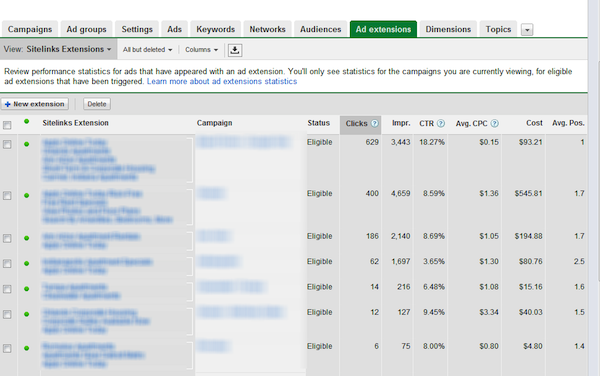In September, I shared 11 great points about Google AdWords Sitelinks. As with all PPC features, there are a few cons to go along with the pros. My PPC colleagues on Twitter were quick to share the not-so-great aspects of sitelinks. Here’s the list.
1. Conversion Tracking is Painful
If you use the free AdWords conversion tracking, forget about seeing conversion data for sitelinks. It isn’t there. You’ll have to track conversions via your web analytics software. Even then, third-party conversion tracking is glitchy. This is probably the biggest con of using sitelinks – it’s quite difficult to tell if they’re actually converting.
2. No Click Data for Individual Destination URLs
Along the same lines, Google doesn’t display data for each individual sitelink. Instead, data is summarized by campaign – making it impossible to optimize for the best-performing sitelinks using AdWords data alone.
Again, you’ll need to set up tagging in your web analytics program to be able to tell which sitelink is driving traffic to your site. However, bear in mind that you won’t get impression data from your web analytics tool, so it’ll be impossible to figure out what your click-through rate is. This is yet another huge hole in the sitelinks reporting picture.

3. Sitelinks Are Only Available at the Campaign Level
Sitelinks will display for all ads in a campaign that qualify for the top-of-page spot. Therefore, it’s necessary to make sure your sitelinks are relevant to all ads in a campaign. Several of my Twitter colleagues expressed the desire to set up sitelinks at the ad group level, which makes a lot of sense.
4. Relevance can be a Problem
This issue is related to the campaign-only issue above: unless your PPC campaigns are tightly themed, your sitelinks may not be relevant to every ad in your campaign. So if you’re planning to use sitelinks, make sure you keep them generic enough to be relevant to all the searches.
5. Sitelinks can’t be Paused – They can Only be Deleted
This is yet another huge failing of sitelinks. Let’s say you’re an ecommerce advertiser who’s using sitelinks to promote specific products. Let’s also say that one of these products is temporarily out of stock. The logical thing to do would be to pause that sitelink until the product is in stock again. No can do.
You’ll have to either leave the sitelink active, thereby killing your cost per conversion and irritating customers who want to buy the out-of-stock item; or you’ll have to delete the sitelink and re-create it when the product is back in stock. Why can’t we just have a pause option instead?
6. Sitelinks can’t be Tested
Unlike ad copy, there is no A/B rotation of sitelinks – you have to craft the copy and hope for the best. In fact, this is kind of a double whammy because data for individual sitelinks isn’t available in AdWords, you’re really winging it here (unless you have tracking set up in your web analytics program). This omission is particularly puzzling to me, because AdWords offers so many other testing options – why not for sitelinks?
7. Sitelinks Trump Other Extensions
If your campaign includes not only sitelinks, but location or product extensions, sitelinks will trump the other extensions. This means you’ll need to think carefully about which extensions are going to add the most value to your campaign’s performance – and remember, you won’t get granular data from AdWords, so you’ll have to guess carefully.
8. Sitelinks can Distract From Ad Copy
One of the great things about sitelinks is their visibility – and it’s one of the not-so-great things about sitelinks, too. If your ad copy includes a special offer or other unique selling proposition, you’ll probably want to include it in your sitelinks too, or else the offer may not be noticed.
Again, remember sitelinks show at the campaign level, so that offer needs to apply to all ad groups in your campaign. Is your head spinning yet?
9. Sitelink Performance May Vary
Several of my Twitter colleagues said they’ve seen huge jumps in click-through rate as a result of implementing sitelinks – but that sitelinks also brought an influx of non-converting queries. I’ve seen this in our client campaigns as well – in some instances, we saw a huge increase in cost per conversion after implementing sitelinks. With limited tracking and no testing, this is a big concern.
While sitelinks can be a powerful addition to your PPC campaigns, it’s clear that there are several factors to consider before implementing them.
Special thanks to all who contributed to this post on Twitter: Andy Groller, Cassie Allinger, Kevin Hill, Lisa Sanner, Luke Alley, Matt Umbro, Michelle Morgan, Andrew Baker, and James Hume.
